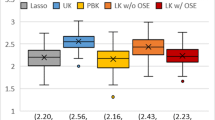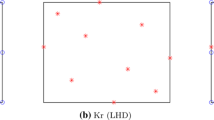Abstract
This paper aims to assess the potential of Kriging combined with partial least squares (KPLS) for fast uncertainty quantification and sensitivity analysis in high-dimensional problems. Such a fast assessment is especially important in cases that involve a large number of outputs such as uncertain scalar fields or applications in robust and reliability-based optimization. In this regard, the role of the partial least squares is to reduce the dimensionality of the input space to accelerate model construction. We conduct experiments using KPLS on analytical and nonanalytical problems of various complexities and compare various quantities of interest (QOI), i.e., mean, standard deviation, and Sobol sensitivity indices, to those from the original Kriging to perform this assessment. In addition, a comparison with sparse polynomial chaos expansion (PCE) is also performed on nonanalytical problems. Results show that KPLS with four principal components is significantly faster than the ordinary Kriging while yielding comparable accuracy in approximating the statistical moments and Sobol indices. We also observe that KPLS with a proper number of principal components can achieve higher accuracy than Kriging in high-dimensional problems with small sample size, suggesting that the benefit of KPLS is not just on the training time but also accuracy. Finally, we observe no apparent benefits in utilizing KPLS for low-dimensional problems.




















Similar content being viewed by others
Notes
References
Álvarez MA, Lawrence ND (2011) Computationally efficient convolved multiple output gaussian processes. J Mach Learn Res 12:1459–1500
Bartoli N, Lefebvre T, Dubreuil S, Olivanti R, Priem R, Bons N, Martins JR, Morlier J (2019) Adaptive modeling strategy for constrained global optimization with application to aerodynamic wing design. Aerospace Sci Technol 90:85–102
Blatman G, Sudret B (2011) Adaptive sparse polynomial chaos expansion based on least angle regression. J Comput Phys 230(6):2345–2367
Bouhlel MA, Martins JR (2019) Gradient-enhanced kriging for high-dimensional problems. Eng Comp 35(1):157–173
Bouhlel MA, Bartoli N, Otsmane A, Morlier J (2016) Improving kriging surrogates of high-dimensional design models by partial least squares dimension reduction. Struct Multidisc Optim 53(5):935–952. https://doi.org/10.1007/s00158-015-1395-9
Bouhlel MA, Bartoli N, Regis RG, Otsmane A, Morlier J (2018) Efficient global optimization for high-dimensional constrained problems by using the kriging models combined with the partial least squares method. Eng Optim 50(12):2038–2053
Byrd RH, Lu P, Nocedal J, Zhu C (1995) A limited memory algorithm for bound constrained optimization. SIAM J Sci Comput 16(5):1190–1208
Constantine PG (2015) Active subspaces: Emerging ideas for dimension reduction in parameter studies, vol 2. SIAM
Constantine PG, Emory M, Larsson J, Iaccarino G (2015) Exploiting active subspaces to quantify uncertainty in the numerical simulation of the hyshot ii scramjet. J Comput Phys 302:1–20
Cui C, Zhang Z (2018) Uncertainty quantification of electronic and photonic ics with non-gaussian correlated process variations. In: Proceedings of the International Conference on Computer-Aided Design, pp 1–8
Dimov I, Georgieva R (2010) Monte carlo algorithms for evaluating sobol’sensitivity indices. Math Comput Simul 81(3):506–514
Dodson M, Parks GT (2009) Robust aerodynamic design optimization using polynomial chaos. J Aircr 46(2):635–646
Geladi P, Kowalski BR (1986) Partial least-squares regression: a tutorial. Analytica Chimica Acta 185:1–17
Geneva N, Zabaras N (2019) Quantifying model form uncertainty in reynolds-averaged turbulence models with bayesian deep neural networks. J Comput Phys 383:125–147
Hoeffding W (1948) A class of statistics with asymptotically normal distribution. Annals Math Stat 19(3):293–325
Konakli K, Sudret B (2016) Reliability analysis of high-dimensional models using low-rank tensor approximations. Probab Eng Mech 46:18–36
Kucherenko S, Feil B, Shah N, Mauntz W (2011) The identification of model effective dimensions using global sensitivity analysis. Reliab Eng Syst Safety 96(4):440–449
Kumar D, Alam SB, Vučinić D, Lacor C (2020) Uncertainty quantification and robust optimization in engineering. Advances in visualization and optimization techniques for multidisciplinary research. Springer, Berlin, pp 63–93
Lataniotis C, Marelli S, Sudret B (2020) Extending classical surrogate modeling to high dimensions through supervised dimensionality reduction: a data-driven approach. Int J Uncertain Quant 10(1):55–82
Li CC, Der Kiureghian A (1993) Optimal discretization of random fields. J Eng Mech 119(6):1136–1154
Lüthen N, Marelli S, Sudret B (2020) Sparse polynomial chaos expansions: Literature survey and benchmark. arXiv preprint arXiv:2002.01290
Marelli S, Sudret B (2014) Uqlab: A framework for uncertainty quantification in matlab. In: Vulnerability, uncertainty, and risk: quantification, mitigation, and management, pp 2554–2563
Marelli S, Sudret B (2018) An active-learning algorithm that combines sparse polynomial chaos expansions and bootstrap for structural reliability analysis. Struct Safety 75:67–74
Nayebi A, Munteanu A, Poloczek M (2019) A framework for bayesian optimization in embedded subspaces. In: International Conference on Machine Learning, pp 4752–4761
Neves Carneiro G, Antonio CC (2019) Reliability-based robust design optimization with the reliability index approach applied to composite laminate structures. Compos Struct 209:844–855
Palar PS, Shimoyama K (2017) Multi-fidelity uncertainty analysis in cfd using hierarchical kriging. In: 35th AIAA Applied Aerodynamics Conference, p 3261
Pan Q, Dias D (2017) Sliced inverse regression-based sparse polynomial chaos expansions for reliability analysis in high dimensions. Reliab Eng Syst Safety 167:484–493
Prieur C, Viry L, Blayo E, Brankart JM (2019) A global sensitivity analysis approach for marine biogeochemical modeling. Ocean Modelling 139:101402
Rackwitz R (2001) Reliability analysis-a review and some perspectives. Struct Safety 23(4):365–395
Ren C, Xiong F, Mo B, Chawdhury A, Wang F (2021) Design sensitivity analysis with polynomial chaos for robust optimization. Struct Multidisc Optim 63(1):357–373
Roy A, Manna R, Chakraborty S (2019) Support vector regression based metamodeling for structural reliability analysis. Probab Eng Mech 55:78–89
Sacks J, Welch WJ, Mitchell TJ, Wynn HP (1989) Design and analysis of computer experiments. Stat Sci 4(4):409–423
Saltelli A (2002) Making best use of model evaluations to compute sensitivity indices. Comput Phys Commun 145(2):280–297
Saltelli A, Annoni P, Azzini I, Campolongo F, Ratto M, Tarantola S (2010) Variance based sensitivity analysis of model output. Design and estimator for the total sensitivity index. Comput Phys Commun 181(2):259–270
Santner TJ, Williams BJ, Notz WI, Williams BJ (2003) The design and analysis of computer experiments, vol 1. Springer, Berlin
Schobi R, Sudret B, Marelli S (2017) Rare event estimation using polynomial-chaos kriging. ASCE-ASME J Risk Uncertain Eng Syst 3(2):D4016002. https://doi.org/10.1061/AJRUA6.0000870
Sobol IM (2001) Global sensitivity indices for nonlinear mathematical models and their monte carlo estimates. Math Comput Simul 55(1–3):271–280
Sobol IM (2001) Global sensitivity indices for nonlinear mathematical models and their monte carlo estimates. Math Comput Simul 55(1–3):271–280
Sobol’ IM (2003) Theorems and examples on high dimensional model representation. Reliab Eng Syst Safety 79(2):187–193
Sudret B (2008) Global sensitivity analysis using polynomial chaos expansions. Reliab Eng Syst Safety 93(7):964–979
Tezzele M, Salmoiraghi F, Mola A, Rozza G (2018) Dimension reduction in heterogeneous parametric spaces with application to naval engineering shape design problems. Advanced Model Simul Eng Sci 5(1):25
Tripathy R, Bilionis I, Gonzalez M (2016) Gaussian processes with built-in dimensionality reduction: applications to high-dimensional uncertainty propagation. J Comput Phys 321:191–223
Tripathy RK, Bilionis I (2018) Deep uq: Learning deep neural network surrogate models for high dimensional uncertainty quantification. J Comput Phys 375:565–588
Wang Z, Hutter F, Zoghi M, Matheson D, de Feitas N (2016) Bayesian optimization in a billion dimensions via random embeddings. J Artif Intell Res 55:361–387
Williams CK, Rasmussen CE (1996) Gaussian processes for regression. In: Advances in neural information processing systems, pp 514–520
Witteveen J, Doostan A, Chantrasmi T, Pecnik R, Iaccarino G (2009) Comparison of stochastic collocation methods for uncertainty quantification of the transonic rae 2822 airfoil. In: Proceedings of workshop on quantification of CFD uncertainties
Xiu D, Karniadakis GE (2002) The wiener-askey polynomial chaos for stochastic differential equations. SIAM J Sci Comput 24(2):619–644
Xu J, Zhu S (2019) An efficient approach for high-dimensional structural reliability analysis. Mech Syst Signal Process 122:152–170
Yamazaki W (2015) Stochastic drag analysis via polynomial chaos uncertainty quantification. Trans Jpn Soc Aeronaut Space Sci 58(2):89–99
Zhu Y, Zabaras N (2018) Bayesian deep convolutional encoder-decoder networks for surrogate modeling and uncertainty quantification. J Comput Phys 366:415–447
Acknowledgements
Lavi Rizki Zuhal and Pramudita Satria Palar were funded in part through the Riset Unggulan ITB Program administered by Institut Teknologi Bandung. The authors would also like to thank Nathan for generating the cantilever beam dataset.
Author information
Authors and Affiliations
Corresponding author
Ethics declarations
Conflicts of interest
On behalf of all authors, the corresponding author states that there is no conflict of interest.
Replications of results
The code for ordinary Kriging and KPLS is available at https://github.com/flowdiagnosticsitb/KADAL. UQLab is available at: https://www.uqlab.com/ The dataset is available at: https://drive.google.com/drive/folders/164AqOD022UsYVOrdgE5iDNAt8BMYAq4a
Additional information
Responsible Editor: Tae Hee Lee
Publisher's Note
Springer Nature remains neutral with regard to jurisdictional claims in published maps and institutional affiliations.
Appendix A: Polynomial Chaos Expansion
Appendix A: Polynomial Chaos Expansion
The nonintrusive version of PCE approximates the black-box function as a sum of orthogonal polynomials \(\varvec{\Psi }=\{\Psi _{0},\ldots ,\Psi _{P-1}\}^{T}\) multiplied by the respective coefficients \(\varvec{\alpha }=\{\alpha _{0},\ldots ,\alpha _{P-1}\}\), where \(\Psi _{i}\) is an individual multidimensional orthogonal polynomial and P is the cardinality of the polynomial basis set \(\varvec{\Psi }\). The family of orthogonal polynomial is different for a given distribution \(\varvec{\rho }(\varvec{\xi })\), e.g., Legendre and Hermite polynomials are used for uniform and normal distribution, respectively. Formally, a PCE approximation is defined as
where \(\varvec{\zeta }=\{\zeta _{1},\ldots ,\zeta _{m}\}\), with \(\zeta _{i}=0,1,2,\ldots\), is an individual - index and \({\mathcal {A}}_{p} \in {\mathbb {N}}^{m}\) is a multi-index set. The multidimensional individual basis \(\Psi _{i}\) itself is the product of one-dimensional orthogonal polynomials, i..e, \(\Psi _{\varvec{\zeta }}(\varvec{\xi }) = \psi ^{i}_{\zeta _{1}}(\xi _{1})\times \ldots ,\times \psi ^{m}_{\zeta _{m}}(\xi _{m})\). In this paper, the multi-index set is generated by a hyperbolic truncation technique, i.e., \({\mathcal {A}}_{p,\nu } \equiv \{\varvec{\zeta } \in {\mathbb {N}}^{m}: ||\varvec{\zeta }||_{\nu } \le p\}\) where \(|| \varvec{\zeta }||_{\nu } \equiv \big (\sum \nolimits_{i=1}^{m}\zeta _{i}^{\nu } \big )^{1/\nu }\) and \(\nu\) is a scalar for hyperbolic truncation in the range of (0, 1]. Notice that using \(\nu =1\) equals to the standard total-order truncation while setting \(\nu <1\) will reduce the number of polynomial bases in the set.
Calculation of \(\varvec{\alpha }\) is done by the standard ordinary least squares (OLS), that is, \(\varvec{\alpha } = ({\varvec{F}}^{T}{\varvec{F}})^{-1}{\varvec{F}}^{T}{\varvec{y}}\) where \({\varvec{F}} = \{\varvec{\Psi }^{(1)},\ldots ,\varvec{\Psi }^{(n)}\}\) is the \(n \times P\) regression matrix. However, the use of OLS is only possible when \(n<m\). The recommended approach is to use the sparse approximation to calculate \(\varvec{\alpha }\), in which only the important polynomials that are given the nonzero coefficients. In this paper, we utilize the least-angle regression (LARS) to construct a sparse PCE approximation based on the given polynomial set \({\mathcal {A}}_{p,\nu }\) (Blatman and Sudret 2011), with the parameters are set to \(\nu =0.4\) and the order is varied from \(p=1\) to \(p=8\).
Rights and permissions
Springer Nature or its licensor (e.g. a society or other partner) holds exclusive rights to this article under a publishing agreement with the author(s) or other rightsholder(s); author self-archiving of the accepted manuscript version of this article is solely governed by the terms of such publishing agreement and applicable law.
About this article
Cite this article
Zuhal, L.R., Faza, G.A., Palar, P.S. et al. Performance assessment of Kriging with partial least squares for high-dimensional uncertainty and sensitivity analysis. Struct Multidisc Optim 66, 115 (2023). https://doi.org/10.1007/s00158-023-03547-3
Received:
Revised:
Accepted:
Published:
DOI: https://doi.org/10.1007/s00158-023-03547-3




